Une partie des informations de ce site Web a été fournie par des sources externes. Le gouvernement du Canada n'assume aucune responsabilité concernant la précision, l'actualité ou la fiabilité des informations fournies par les sources externes. Les utilisateurs qui désirent employer cette information devraient consulter directement la source des informations. Le contenu fourni par les sources externes n'est pas assujetti aux exigences sur les langues officielles, la protection des renseignements personnels et l'accessibilité.
L'apparition de différences dans le texte et l'image des Revendications et de l'Abrégé dépend du moment auquel le document est publié. Les textes des Revendications et de l'Abrégé sont affichés :
| (12) Demande de brevet: | (11) CA 2101636 |
|---|---|
| (54) Titre français: | DISQUE DE FREIN COMPOSITE AU CARBONE AVEC AMORTISSEMENT DES VIBRATIONS |
| (54) Titre anglais: | CARBON COMPOSITE BRAKE DISC WITH POSITIVE VIBRATION DAMPING |
| Statut: | Réputée abandonnée et au-delà du délai pour le rétablissement - en attente de la réponse à l’avis de communication rejetée |
| (51) Classification internationale des brevets (CIB): |
|
|---|---|
| (72) Inventeurs : |
|
| (73) Titulaires : |
|
| (71) Demandeurs : |
|
| (74) Agent: | MACRAE & CO. |
| (74) Co-agent: | |
| (45) Délivré: | |
| (86) Date de dépôt PCT: | 1992-01-21 |
| (87) Mise à la disponibilité du public: | 1992-08-15 |
| Licence disponible: | S.O. |
| Cédé au domaine public: | S.O. |
| (25) Langue des documents déposés: | Anglais |
| Traité de coopération en matière de brevets (PCT): | Oui |
|---|---|
| (86) Numéro de la demande PCT: | PCT/US1992/000480 |
| (87) Numéro de publication internationale PCT: | US1992000480 |
| (85) Entrée nationale: | 1993-07-29 |
| (30) Données de priorité de la demande: | ||||||
|---|---|---|---|---|---|---|
|
2101636 9214946 PCTABS00015
A carbon composite aircraft brake disc (10, 50, 60, 110, 120) is
manufactured to include internally an insert member (12, 14, 18,
24, 28, 32, 36, 42, 52, 115, 125) which effects positive
vibration damping for the disc (10, 50, 60, 110, 120) during operation of
the brake (100). The insert member (12, 14, 18, 24, 28, 32, 36,
42, 52, 115, 125) may be a graphite material, paper, or cloth
material which is introduced into the interior of material utilized
for manufacturing the carbon composite aircraft disc (10, 50, 60,
110, 120). After manufacturing of the brake disc (10, 50, 60,
110, 120) is completed, the brake disc comprises a single integral
carbon composite brake disc (10, 50, 60, 110, 120) having
disposed completely internally therein the insert member which provides
a discontinuity that effects efficiently positive vibration
damping of the disc (10, 50, 60, 110, 120) during operation of the
aircraft brake (100) in which the disc is located.
Note : Les revendications sont présentées dans la langue officielle dans laquelle elles ont été soumises.
Note : Les descriptions sont présentées dans la langue officielle dans laquelle elles ont été soumises.

2024-08-01 : Dans le cadre de la transition vers les Brevets de nouvelle génération (BNG), la base de données sur les brevets canadiens (BDBC) contient désormais un Historique d'événement plus détaillé, qui reproduit le Journal des événements de notre nouvelle solution interne.
Veuillez noter que les événements débutant par « Inactive : » se réfèrent à des événements qui ne sont plus utilisés dans notre nouvelle solution interne.
Pour une meilleure compréhension de l'état de la demande ou brevet qui figure sur cette page, la rubrique Mise en garde , et les descriptions de Brevet , Historique d'événement , Taxes périodiques et Historique des paiements devraient être consultées.
| Description | Date |
|---|---|
| Inactive : CIB de MCD | 2006-03-11 |
| Inactive : CIB de MCD | 2006-03-11 |
| Le délai pour l'annulation est expiré | 2000-01-21 |
| Demande non rétablie avant l'échéance | 2000-01-21 |
| Réputée abandonnée - omission de répondre à un avis sur les taxes pour le maintien en état | 1999-01-21 |
| Inactive : Abandon.-RE+surtaxe impayées-Corr envoyée | 1999-01-21 |
| Demande publiée (accessible au public) | 1992-08-15 |
| Date d'abandonnement | Raison | Date de rétablissement |
|---|---|---|
| 1999-01-21 |
Le dernier paiement a été reçu le 1997-12-31
Avis : Si le paiement en totalité n'a pas été reçu au plus tard à la date indiquée, une taxe supplémentaire peut être imposée, soit une des taxes suivantes :
Les taxes sur les brevets sont ajustées au 1er janvier de chaque année. Les montants ci-dessus sont les montants actuels s'ils sont reçus au plus tard le 31 décembre de l'année en cours.
Veuillez vous référer à la page web des
taxes sur les brevets
de l'OPIC pour voir tous les montants actuels des taxes.
| Type de taxes | Anniversaire | Échéance | Date payée |
|---|---|---|---|
| TM (demande, 6e anniv.) - générale | 06 | 1998-01-21 | 1997-12-31 |
Les titulaires actuels et antérieures au dossier sont affichés en ordre alphabétique.
| Titulaires actuels au dossier |
|---|
| ALLIED-SIGNAL INC. |
| Titulaires antérieures au dossier |
|---|
| MCALLISTER LAWRENCE EDWARD |
| DAVID ROSS SNYDER |
| JARING VANDER VEEN |